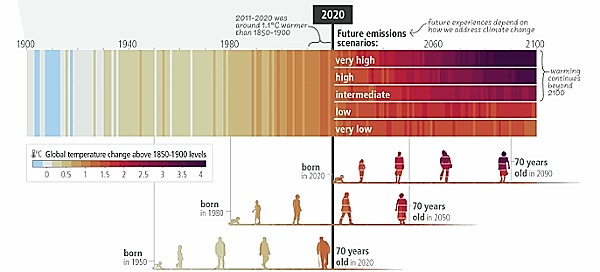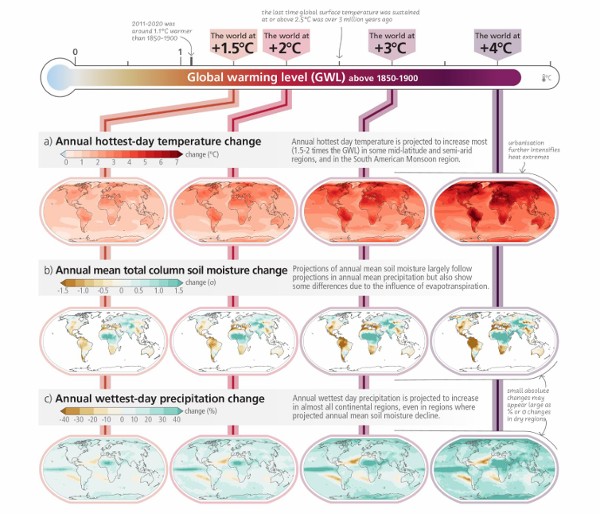The latest published report from the IPCC begins with an acknowledgement that “recognizes the interdependence of climate, ecosystems and biodiversity, and human societies.” This sixth assessment notes “the close linkages between climate change adaptation, mitigation, ecosystem health, human well-being and sustainable development.” And for the first time it links human activity “unequivocally” without hesitation to observed atmospheric warming. No previous IPCC report made such a conclusive argument.
The Metrics of Global Anthropogenic Climate Change
- Mean surface temperatures looking at records between 1850 and 1900 to what has been observed between 2011 and 2020 have risen by 1.1 Celsius (2.0 Fahrenheit).
- Mean atmospheric temperatures over land have risen 1.59 Celsius (2.86 Fahrenheit) while ocean temperatures have risen 0.88 Celsius (1.58 Fahrenheit).
- The rise in mean atmospheric temperatures has been faster since 1970 than in any prior 50-year period going back the last 2,000 years.
- The rise in sea level from 1901 to 2018 amounts to 0.20 metres (7.87 inches).
- The rate of sea level rise is accelerating with the largest increases occurring between 2006 and 2018 at a rate of 3.7 millimetres (0.146 inches) per year.
The Metrics of Greenhouse Gas (GHG) Emissions
GHG increases correlate to atmospheric temperature increases. Here is a direct quote about changes in GHG concentrations.
“In 2019, atmospheric CO2 concentrations (410 parts per million) were higher than at any time in at least 2 million years….and concentrations of methane (1,866 parts per billion) and nitrous oxide (332 parts per billion) were higher than at any time in at least 800,000 years.”
All of these named gasses are GHGs.
A 10,000 Metre View Correlated to Planetary Impacts
A section of the Summary for Policymakers in the report is called “Observed Changes and Impacts.” Among these are the following:
- Human population vulnerability is increasing with between 3.3 and 3.6 billion at risk from stresses on supporting ecosystems and weather extremes. The largest impacts are disproportionately on the Developing World nations to be found in Africa, Asia, Central and South America, small islands, and in the Arctic and Indigenous and remote communities.
- Global atmospheric warming is creating climate refugees with populations on the move. Where climate stress is impacting rural populations, the movement is to cities that increasingly are experiencing urban heat island extreme effects with adverse impacts on human health and working conditions.
- Irreversible losses are being seen among freshwater, open ocean, polar and alpine ecosystems. Losses are unequally distributed across the planet’s many regions and ecosystems.
- Technological innovation in agriculture continues to produce positive results but the pace of crop yield increases has slowed in the last 50 years as climate change-causing extremes impact precipitation, soil, and surface and groundwater sources. For a portion of every year now these changes are impacting roughly half of the world’s population.
- The absorption of CO2 by the ocean, the planet’s largest natural carbon sink is changing the pH levels making the water more acidic. At the same ocean surface temperatures are rising with profound impacts throughout the water column all the way to the sea floor with the combination of these measurable phenomena having an adverse impact on aquaculture and fisheries.
- Losses and damages to nature and people are unequally distributed across the planet beyond agriculture and fisheries to impact economic activities from energy production to tourism and forestry.
- Destruction of homes and infrastructure is on the rise leading to increased losses of property, income, human health and job and food security. In cities, heat extremes have intensified impacting infrastructure, transportation, water, sanitation and energy systems.
What This Means For My Daughter and Granddaughter

Take a look at the above illustration. I was born in 1949 so you can see the impact of global warming on me at the very bottom of the picture. My daughter was born in 1984 which conforms closely to the second from the bottom timeline. And my granddaughter who recently turned two is represented approximately by the timeline that appears above my daughter’s.
The illustration is human action dependent showing both historic emissions and temperatures and future projections. Global temperature rises are based on the level of GHG emissions we continue to put into the atmosphere.
So if I make it to 90, the warming by 2039 under a low emissions future where we bend the curve downward toward the net-zero goal of 2050, could be limited to 2 Celsius (3.6 Fahrenheit). But if emissions continue to remain high, at age 90 I’ll likely witness mean temperatures exceeding 3 Celsius (5.4 Fahrenheit) more than the day I came into the world.
For my daughter should she achieve that same 90 milestone in the year 2074, if we have achieved net zero, we should begin to drawdown on GHG emissions, keeping the temperature rise to no more than 2 Celsius (3.6 Fahrenheit). But if we fail to curb emissions, atmospheric temperatures will approach 3.5 Celsius (6.3 Fahrenheit) more than on the day she was born.
And for my granddaughter, who would turn 90 in the year 2111, if high emissions continue, she would be living in an environment where temperatures will have increased by 4.0 Celsius (7.2 Fahrenheit) more than on her birth date.
If that’s not a call to action for the human race, what is?
















